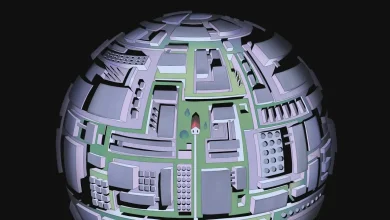Valve’s New Steam Machine Could Disrupt Console Gaming as We Know It

Valve is entering the console race, and it’s doing so in the most Valve way possible. The Steam Machine is exactly what it sounds like: a bundle of PC parts inside a pint-sized frame that can play your Steam library natively. The company even has a revised Steam Controller to keep you entertained. It’s all a little wonky, but it has the chance to completely reshape both console and PC gaming. Just don’t call it a “GameCube.”
As expected, Valve showcased a slew of new hardware on Wednesday, including a new Steam Frame VR headset built to play both virtual reality titles and the rest of your Steam library on a virtual 2D screen. As earlier leaks suggested, the new Steam Machine includes a “semi-custom” AMD-made SoC, or system on a chip. Valve claims the new box has “six times the horsepower” of the custom Zen 2 AMD-made CPU on the Steam Deck. The Steam Machine is a small, six-inch cube that promises 4K gaming at 60 fps (only when using AMD’s FidelityFX Super Resolution AI upscaling technology).
The Steam Machine comes with either 512GB or 2TB of storage, though like the Steam Deck, you can expand that with a microSD. Like the Xbox Series X and PS5, the Steam Machine has its power supply built in; no fat brick dangling outside. As a touch of aesthetics, the roughly 6 x 6-inch gaming system includes a small LED strip that will light up when you’re downloading games or glow based on your custom animations. Valve will also let you customize the front plate, though Valve hasn’t said whether it will sell any first-party mods, so you may need to 3D print your own. In its announcement video, Valve showed the console with a wood grain front plate and another with a logo-filled graffiti aesthetic.
© Valve
The console’s six-core, 12-thread CPU uses AMD’s Zen 4 microarchitecture and hits a 4.8GHz clock speed at a max 30W TDP, or thermal design power. The GPU is based on AMD’s slightly older RDNA 3 technology, though it sports 28 Compute Units—AMD’s word for its chip’s core clusters. It hits a max 2.45GHz sustained clock speed and demands 110W TDP. That GPU is using just 8GB of VRAM, while the system itself sports a mere 16GB of DDR5 memory. If it can hit PlayStation 5 levels of performance or better, that would be significant for such a small device. However, whether you’ll get stable performance at 4K resolution will heavily depend on the game. IGN reported the Steam Machine managed playable frame rates in Cyberpunk 2077 at medium settings with some ray-traced options enabled. The system struggled to push Silent Hill F at 4K.
The console has a variety of ports to stick any dongles and displays into. There are four USB-A ports split between the front and rear, plus a single USB-C. You otherwise get a single HDMI and DisplayPort plus Ethernet and microSD for expanding storage. If you want to treat this like a console as much as possible, Valve promised to establish a new way of seeing which games work best on Steam Machine. Like its Steam Deck Verified badges, Steam will now show Steam Machine Verified on games that can run well on the 6-inch system. If the Steam Deck was already a console-like experience, the Steam Machine will offer a more standardized PC experience you can stick next to your TV.
A new Steam Controller
This is the new Steam Controller. © Valve
The newfangled Steam Controller is far more wonky than the console itself. Like the original Steam Controller from 2014, it includes two large touchpads made for controlling games with mouse-based controls. However, it also includes two drift-resistant TMR (tunneling magnetoresistance) joysticks and a suite of face buttons for couch-based gaming. There’s also a built-in gyroscope, but unlike a Switch 2 Pro controller, any motion controls activate when you grip the controller a certain way or put your thumbs on top of the joysticks. The controller also comes with a charging puck that doubles as a 2.4GHz receiver when it’s plugged into any other PC. The receiver is built into the Steam Machine already.
We’ve seen the capabilities of the AMD Ryzen AI Max 385 on the Framework Desktop, and it proved a surprisingly capable machine despite its size. Valve told The Verge the device could be as powerful as today’s consoles like the PlayStation 5 or even the PlayStation 5 Pro.
© Valve; Screenshot by Gizmodo
Valve has intermittently tried to push so-called “Steam Machines” for more than a decade. The concept is sound: take a few PC parts, put them in a machine, and sell it for playing your Steam library from the comfort of your couch. The concept died on the vine, probably due to a host of issues manufacturing a small gaming-ready device that could meet the demands of PC gamers for a reasonable price. Valve also had to take the time to perfect gaming on Linux and finally break away from the Windows paradigm.
The Steam Deck finally proved Valve’s concept had legs. The Steam Deck OLED from 2023 is still the most popular handheld PC, and SteamOS is a preferable operating system to Windows on devices like the Lenovo Legion Go S. Microsoft tried to push back with a Windows “Full Screen Experience” on the Asus ROG Xbox Ally X, but it’s nowhere close to the versatility of Valve’s console-like interface and excellent Proton compatibility layer. Valve’s OS regularly outperforms Windows on the same hardware.
More details in 2026
© Valve
Valve hasn’t shared pricing or specific release date information for any of its new Steam hardware. We only know that the Steam Machine will launch in “early 2026.” With Microsoft driving Xbox into the ground, there’s now room for a player like Valve to challenge Sony head-on for the living room. Nintendo will keep doing its own thing—the Switch 2 is unstoppable right now, and there’s no sign of things slowing down for the Mario and Zelda maker. But console gaming as we know it—it’s about to change big time.





